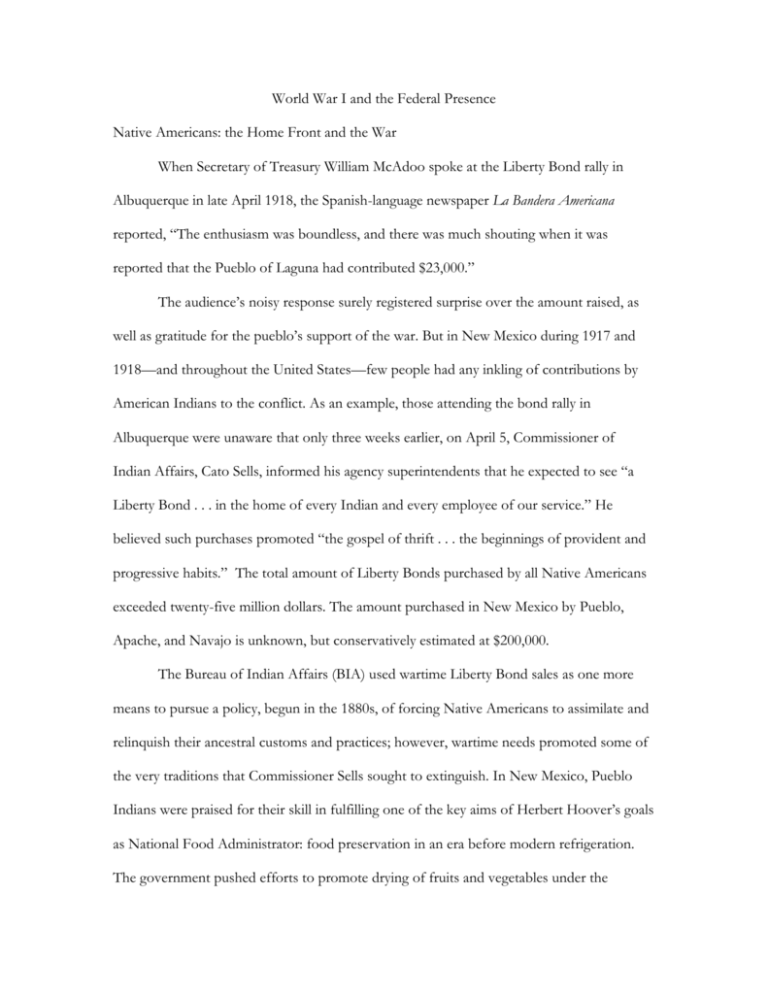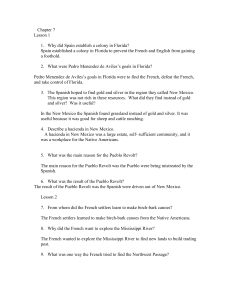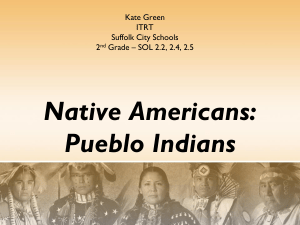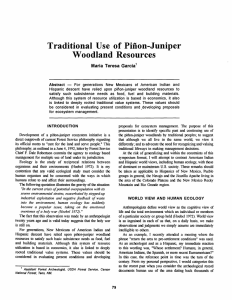WWI and Native Americans
advertisement

World War I and the Federal Presence Native Americans: the Home Front and the War When Secretary of Treasury William McAdoo spoke at the Liberty Bond rally in Albuquerque in late April 1918, the Spanish-language newspaper La Bandera Americana reported, “The enthusiasm was boundless, and there was much shouting when it was reported that the Pueblo of Laguna had contributed $23,000.” The audience’s noisy response surely registered surprise over the amount raised, as well as gratitude for the pueblo’s support of the war. But in New Mexico during 1917 and 1918—and throughout the United States—few people had any inkling of contributions by American Indians to the conflict. As an example, those attending the bond rally in Albuquerque were unaware that only three weeks earlier, on April 5, Commissioner of Indian Affairs, Cato Sells, informed his agency superintendents that he expected to see “a Liberty Bond . . . in the home of every Indian and every employee of our service.” He believed such purchases promoted “the gospel of thrift . . . the beginnings of provident and progressive habits.” The total amount of Liberty Bonds purchased by all Native Americans exceeded twenty-five million dollars. The amount purchased in New Mexico by Pueblo, Apache, and Navajo is unknown, but conservatively estimated at $200,000. The Bureau of Indian Affairs (BIA) used wartime Liberty Bond sales as one more means to pursue a policy, begun in the 1880s, of forcing Native Americans to assimilate and relinquish their ancestral customs and practices; however, wartime needs promoted some of the very traditions that Commissioner Sells sought to extinguish. In New Mexico, Pueblo Indians were praised for their skill in fulfilling one of the key aims of Herbert Hoover’s goals as National Food Administrator: food preservation in an era before modern refrigeration. The government pushed efforts to promote drying of fruits and vegetables under the assumption such techniques were a “lost art.” Upon hearing such a claim, “the women [of New Mexico] laughed in their sleeves” since the practice had a long history in the state: “Even in the cliff dwellings there was found evidence that these early settlers practiced the art of conservation—‘some time before the advent of Mr. Hoover.’” To document the Indians’ widespread conservation practice, Mrs. W. E. Lindsey, wife of the governor and head of the state’s Woman’s Committee of the Council of National Defense, sent Hoover photographs “showing Indian pueblos in harvest—roof tops spread with grain, houses hung with chili, the plaza spread with meat, squash, corn, beans, alfalfa, and corn shock, making a veritable picture of plenty.” About 12,000 Native American men served during World War I. New Mexico, which had one of the largest populations of American Indians, contributed about 100 soldiers (nine one-thousandth of a percent). Why so few? A report in 1927 pointed to the reasons: Few even in New Mexico know that nearly a hundred Indians from this state joined the ranks—Jicarilla and Mescalero Apache, Navajoes [sic], Pueblos from Taos, San Juan, Santa Clara, Nambé, San Felipe, Isleta, Jemez, Laguna, Acoma, and Zuñi. Perhaps those who scoffed in 1917 when it was suggested to raise troops among these citizens realized later that hundreds of them might have responded if they had been invited to enlist. In sum: bias coupled with a belief by New Mexico draft officials that the federal Selective Service Act of 1917 did not apply to Native Americans (they were not yet legally recognized as full-fledged citizens). However, many did voluntarily register, especially older Native Americans when, during the final draft registration in 1918, individuals up to age forty-five were included in the call. Concerns over the legal status of Indians led to changes on the final two (of three) draft registrations forms. In July and September 1918, Native Americans for the first time marked “noncitizen or citizen Indian” when registering. Also the September card included the first broad questions on race. Besides American Indian, three further categories—“White, Negro, or Oriental”— appeared for the first time. Native Americans enlistments often had some prompting—either by federal officials or their tribal elders. The BIA’s contact with young men often proved decisive in their choice. The Santa Fe Indian School had long drilled students in military formations, and with the outbreak of war they urged their graduates to enlist. Ten Pueblo and Apache alumni from New Mexico served in the army. At the Pueblo of San Juan (Ohkay Owingeh), the showing of a government propaganda film vilifying Germany’s militarism and rallying America to support the war prompted one member of the pueblo to enlist, and he eventually served in France. Some tribal leaders strongly endorsed military service and, like Mexes of the Mescalero Apache, urged their young men to enlist. The war elicited patriotism and voluntary enlistment at a time few state officials expected much from New Mexico’s Indian population. In combat, records for all Native Americans show they were gassed, shot, and died at a much higher rate than Anglo soldiers. Upon returning home, some New Mexico American Indians sealed their memories and would not talk about the war with relatives, while others drew from it renewed inspiration for traditional celebrations, especially war dances, which the BIA had tried for decades to suppress. On balance, World War I helped subvert the BIA’s assimilation policy and contributed to its ultimate failure. © 2008 by David V. Holtby











